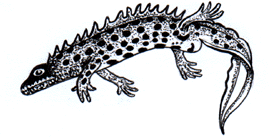The Great Crested Newt
 The great crested, or warty, newt, is the largest of the European newts. It is an amphibian and therefore a close relative of frogs and toads. Amphibians have a soft, porous skin which must be kept moist all the time, so newts never stray far from water. On land, the newts hide under stones or logs by day, coming out at night to hunt for worms, insects, slugs and snails among damp grass or leaves. In spring, the newts return to ponds to breed and there they eat tadpoles (including their own), frog-spawn and small invertebrates. Over the years, great crested newt numbers have been declining and they are protected by law, officially classed as an endangered species.
The great crested, or warty, newt, is the largest of the European newts. It is an amphibian and therefore a close relative of frogs and toads. Amphibians have a soft, porous skin which must be kept moist all the time, so newts never stray far from water. On land, the newts hide under stones or logs by day, coming out at night to hunt for worms, insects, slugs and snails among damp grass or leaves. In spring, the newts return to ponds to breed and there they eat tadpoles (including their own), frog-spawn and small invertebrates. Over the years, great crested newt numbers have been declining and they are protected by law, officially classed as an endangered species.
Reasons for decline - fifty years ago there were twice as many ponds in the countryside than there are today. Most of Britain’s original ponds have been destroyed by pollution, or drained and filed in to make way for buildings and farmland. This has meant that the great crested newt has lost many of its essential breeding sites. In the past the newts were collected in large numbers, reducing the wild population even further.
The future - over recent years there has been an ever-increasing interest in garden ponds and the creation of these has provided the newts with much-needed habitats. This, together with legal protection, may help the great crested newt population to recover.
Read More: The Swallowtail Butterfly